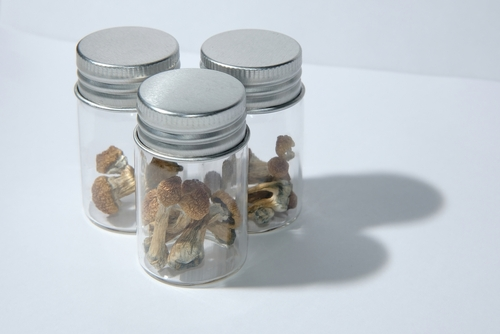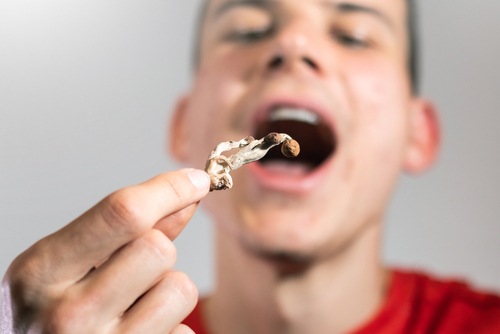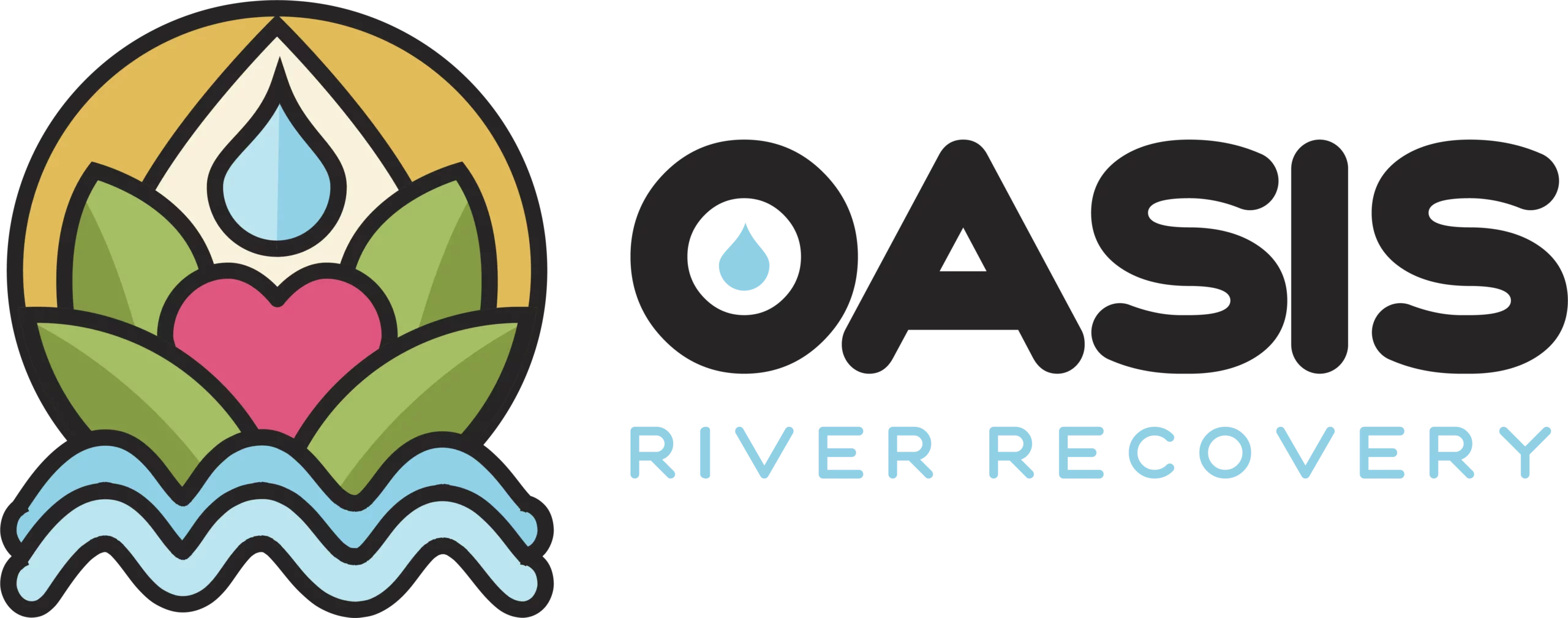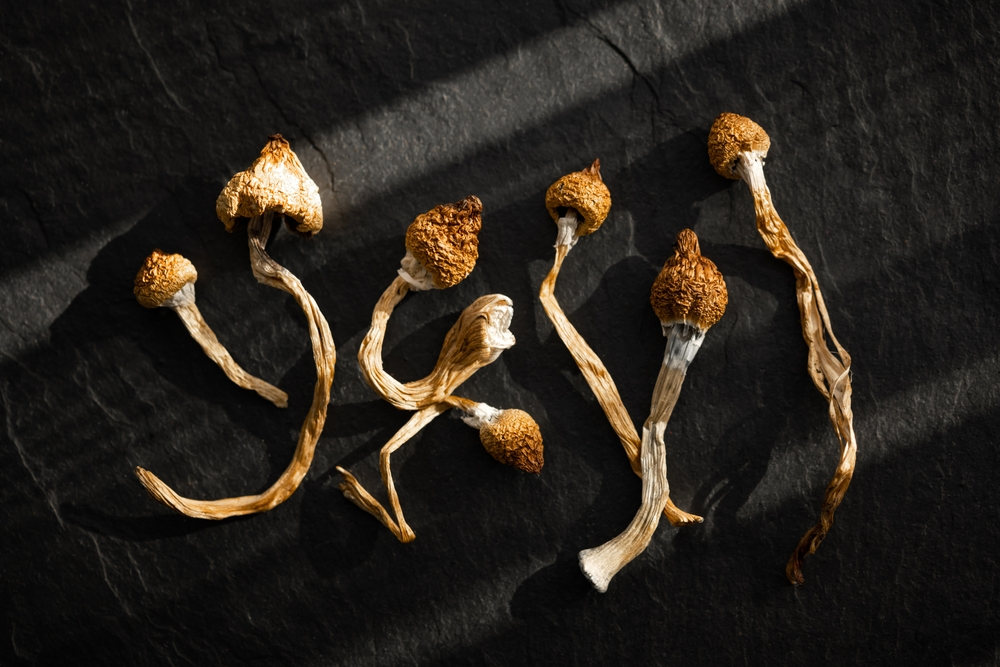If you want to know what coming down from shrooms feels like, this is the article for you. Many articles list benefits and tips on how to ease comedown symptoms, and we felt it was important as an addiction treatment center to break down the short and long-term side effects of using shrooms, if they’re addictive, and ways to experience natural highs and their link to holistic therapy methods.

What Are Shrooms?
Shrooms, also called “magic mushrooms,” are a group of over 180 naturally occurring fungi that contain psilocybin, an inactive prodrug that’s quickly converted to psilocin, inducing psychoactive and hallucinogenic effects similar to lysergic acid diethylamide (LSD), mescaline, and dimethyltryptamine (DMT). These mushrooms are usually dried and directly eaten, taken in pill form, or brewed into tea. Synthetic versions of psilocybin have also been created to treat certain neurological conditions, such as depression, anxiety, and addiction, and appear as white crystalline powder.
The most commonly desired psychedelic effects produced by shrooms include euphoria, feelings of connectivity with others, increased energy, audio-visual hallucinations, and sensory distortions. However, the effects can vary based on dosage and type.
- One gram of psilocybin mushrooms is said to induce euphoria and enhanced senses.
- Two grams induce perceptual distortions and heavy euphoria.
- 3.5 grams induces heavy perceptual distortions and ego dissolution (reduced sense of self).
- The highest recommended dose, 5 grams, is said to cause a complete disconnect from consensus reality.
How Long Do The Effects of Shrooms Last?
The effects of shrooms, depending on the amount and individual factors, usually kick in within 10 to 30 minutes and last between four and six hours. The most intense or noticeable effects peak between two to three hours after ingestion. However, some people have reported feeling residual effects of long after they’ve stopped “tripping,” experiencing a “glow” or boosted mood.
The effects of shrooms can rapidly change while your body metabolizes the psilocin and psilocybin, ranging from positive feelings, such as happiness, joy, and a sense of connection, to uncomfortable feelings, such as anxiety, paranoia, and a sense of loneliness. Some users might have visual hallucinations that can become frightful from negative thoughts. Others might experience synesthesia, where senses can converge and induce audible colors or physical sounds.
Despite the length of effects, psilocin metabolites can be detected in the body through urine tests up to 24 hours after ingestion and up to 72 hours in chronic users.
Read more: Everything Involved In Fentanyl Addiction Treatment

What Does Coming Down From Shrooms Feel Like?
Coming down from shrooms can induce mood changes, headaches, and fatigue since psychoactive substances can be physically and psychologically taxing on your brain and body. If someone uses shrooms to boost their mood after feeling stressed, those anxious and uncertain feelings can return right after the trip.
If someone has a strong sense of loneliness day-to-day, they may be depressed and exhausted once the euphoria and cognitive changes fade. This can be dangerous for individuals who struggle with mental health disorders, especially if they’re undiagnosed.
Other people report experiencing delayed headaches, and chronic users report flashbacks to previous “trip sessions” that induced frightening feelings or hallucinations. However, these were brought on by combining shrooms with other substances, stress, tiredness, and exercise, and only lasted a few minutes.
Long-term effects of coming down from shrooms also include rare cases of psychosis, which are characterized by delusions and hallucinations while sober. However, studies investigating the effects of psilocybin found that there were no adverse contributions to psychosis. They also found that psilocybin had positive results in the treatment of mental health disorders.

Are Shrooms Addictive?
Shrooms are not physically addictive but can be psychologically addictive if someone uses them to deal with stress, anxiety, interpersonal issues, or depression. Some individuals will mix shrooms with other substances, such as cannabis, tobacco, and alcohol, to induce different or intensified effects. However, this can lead to simultaneous substance use disorders, also known as polysubstance dependence.
Not everyone becomes addicted to shrooms, but frequently abusing them and ignoring adverse effects can be the beginning. This includes:
- Building a tolerance to shrooms (requiring higher doses to feel previous effects).
- Strong cravings that can make it hard to function without psilocybin.
- Legal, social, and financial issues as a result of shroom use, such as stealing or spending excessive amounts of money on shrooms and neglecting personal or family responsibilities.
- A loss of interest in a career, social life, or hobby.
- Investing large amounts of time seeking, buying, and using shrooms.
Ways To Experience Natural Highs
As an addiction center that offers holistic healing modalities and experiential therapy methods, we strongly encourage individuals to take advantage of the body’s natural feel-good chemicals through various activities.
- Serotonin: Also called the “happy hormone,” serotonin regulates mood, digestion, brain function, and circadian rhythm. Individuals with low serotonin levels or those who haven’t developed healthy coping skills can turn to shrooms and other drugs to boost their serotonin. 90% of the body’s serotonin production is generated in the gut, and eating foods containing prebiotics and tryptophan can give it a solid boost. Regular exercise is also an easy way to boost happy hormone levels. To support this, Oasis River Recovery takes clients on weekly outdoor excursions, including hikes, walks, kayaking, ziplining, and mountain biking.
- Oxytocin: Oxytocin is the “cuddle hormone” and regulates emotions centered around trust, bonding, love, responsiveness, and gratitude. Shrooms and other substances can falsely replicate these feelings and become a substitute for the senses oxytocin provides. Positive sensory experiences, like Oasis River Recovery’s art therapy and breathwork sessions, can boost oxytocin levels. Other examples include romantic or caring relationships, friendships, animal interaction, and supportive eye contact.
- Dopamine: Dopamine is responsible for pleasure, reward, and motivation, which are all heavily tied to the effects of psychedelic substances. Dopamine can’t be found in food, but its precursor, tyrosine, can and produces 50% of all dopamine levels in your gut. Other ways to boost dopamine levels include getting enough sleep, meditating, music, and being out in the sun, all encouraged and supported at Oasis River Recovery.
- Endorphins: Endorphins are the body’s natural painkillers, which sedative substances can easily substitute. Insufficient endorphin production can lead to increased physical pain, depression, anxiety, irritability, and insomnia. Oasis River Recovery ensures our clients stay active, eat nutritious meals, and utilize their body’s natural functions to stay positive and motivated in recovery.
Read more: Drug Rehabs In Tennessee: Integrating Nature With Treatment

Contact Oasis River Recovery
If you or someone you know is abusing psilocybin mushrooms or any other drug, contact Oasis River Recovery. Our comprehensive addiction treatment center is the perfect place to overcome physically and psychologically addictive substances, including shrooms, LSD, DMT, and mescaline. As mentioned earlier, we take great pride in helping our clients find true wellness in sobriety and resist the cravings and temporary effects of unhealthy substances. Call today, and one of our admissions agents can get you started.



